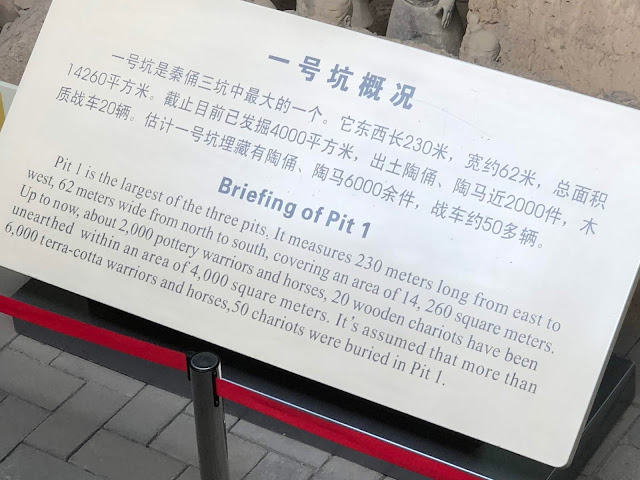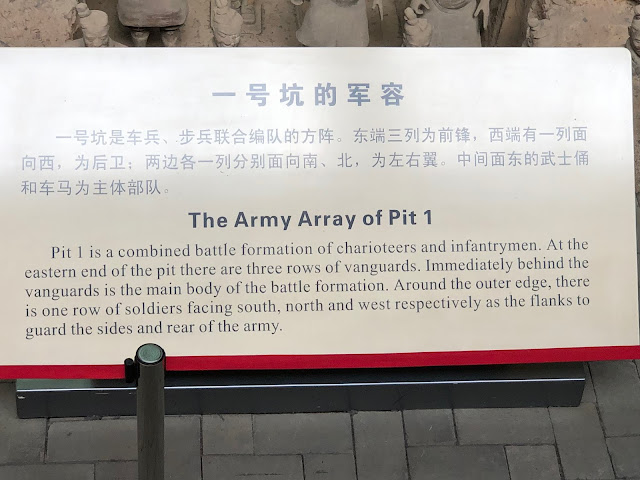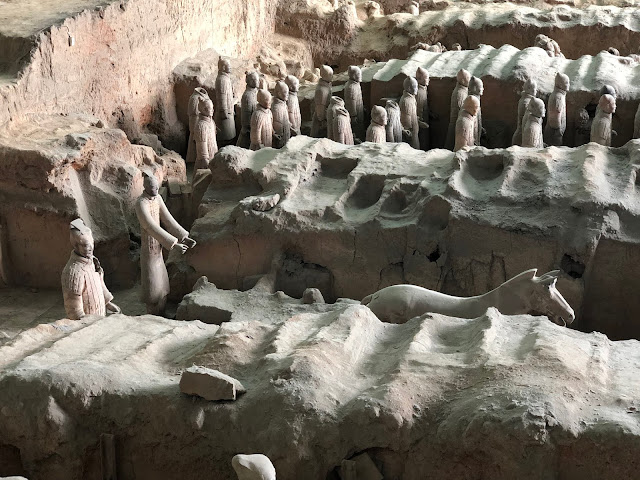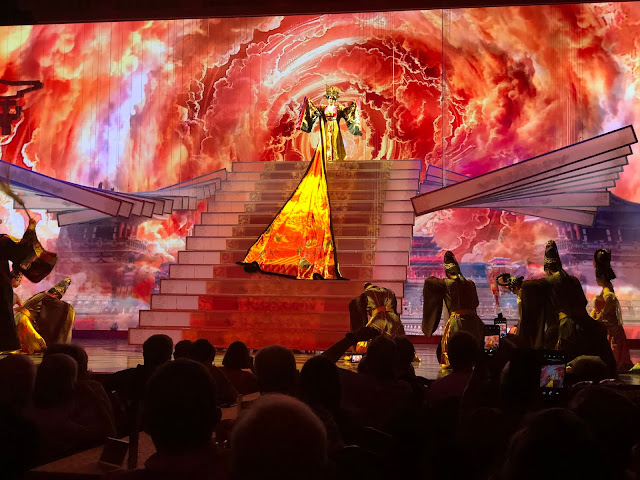We started the day early to avoid the crowds at the First Emperor's burial site. The site is located about an hour's drive from our hotel in the Lintong District east of Xi'an. We had breakfast at 6:30 am and were on the road by 7:30 am. The site opens at 8:30.
The main attraction at the site, which is huge overall (about 4 miles wide and 5 miles in length), is the excavation of the terracotta warriors (bīng mǎ yǒng in Mandarin, 兵马俑 ). It is estimated that there are over 8,000 life-sized soldiers, 130 chariots with 520 horses, and 150 cavalry horses buried along with the Emperor to serve as his army in the afterlife. The figures were discovered in March 1974 by farmers digging a water well approximately one mile east of the Qin Emperor's tomb mound at Mount Li (Lishan).
The excavation work has been going on for the past 45 years and will undoubtedly continue for many more. Ray told us that in 2017, restoration was completed on only 15 warriors. There are many volunteers working at the site, but only 18 certified people are responsible for putting the figures back together.
Why does it take so long to reconstruct each figure?
The unearthed figures are, in general, a mess. Shortly after the fall of the Chin dynasty, a farmer's revolt took place and the farmers raided the site, stole all the weapons that had been buried with the warriors and apparently did their best to destroy the warriors themselves. Putting all the fragments of each of them back together is a huge puzzle.
 |
| Emperor Qin Shi Huang, First Emperor of China |
 |
| Qinling Mountains |
 |
| Entry to Pit #1 |
 |
Each warrior stands about six feet tall
|
 |
| You can see where the chariot would have been, behind the horses and in front of the warrior with the outstretched arms |
 |
| The front rows of the army were "skirmishers", lightly armored and mobile, they were charged with making first contact with the enemy |
 |
| The sign shows the location of the digging of the water well back in 1974. A few feet farther away and they would have never detected the buried warriors |
Computer analysis has concluded that no two faces of the warriors are the same. Ray explained this might not be surprising since each warrior was handmade and there would be natural variations, but he said there is also speculation that the faces might have actually been impressions taken from the live members of the Emperor's army.
Ray told us a story (I assume it was true) about a German tourist who dressed up like a warrior, managed to find a hiding place and was locked in the Pit #1 building overnight. He took up a position along with the other members of the army. The next morning when the site opened to visitors, they were shocked to see one of the terracotta warriors actually move. The tourist was hauled away and not heard of again.
 |
Top Knot on the right side of the head indicated a common soldier.
If it were on the left side of the head, that would mean an archer
|
About one-half of Pit 1 has yet to be excavated. The estimates of the size of the pit has been made by taking core samples which can distinguish between soil that has been once excavated and then refilled from that which has never been disturbed.
Over the areas yet to be excavated, the work of piecing the warriors back together is taking place. Even using computer technology, they are averaging one warrior per person per year, with 18 people working on the restoration. Only Chinese nationals are permitted to do the actual reconstruction work.
The pieces of the warriors are being glued back together.
The warriors originally were solid from the knees down. the body was hollow and a wooden interior skeleton was used to support the molded clay. Still, each warrior weighs close to 300 pounds. The head and hands were made separately and fitted to the body once in place in the pit.
Tape and plastic wrap are used to hold the warriors together until the glue dries.
 |
No photos allowed...oops!
|
If a small piece cannot be found, after extensive investigation, a new piece will be manufactured to complete the body. A missing head however is not replaced with a new one.
 |
| A portion of Pit #1 not having started excavation |
 |
| What lies beneath the earth that has filled the pit over the years, a mass of broken figures. |
After leaving Pit 1, we walked over to Pit 3 which was the command post, with high-ranking officers and a war chariot. There was no "commanding" general in the command post. It is believed that since the Emperor's tomb is nearby, the Emperor himself would be the commanding officer.
 |
| Entry to Pit 3 |
On to Pit 2, the second to be identified. Pit 2 has cavalry and infantry units as well as war chariots and is thought to represent a military guard. The "wavy" earth shown in the areas not excavated are the result of the collapsed wooden roofs and bamboo mats that were originally over the pits.
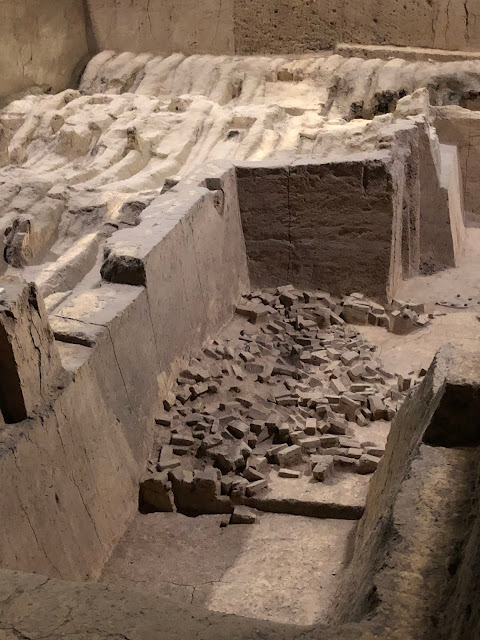 |
| Unused floor tiles |
Most of Pit 2 has yet to be excavated
Core sampling identified Pit 4, but upon excavation, it was found to be empty. The speculation is that it was never finished before the collapse of the dynasty and the subsequent farmer's revolt. The Pit 4 was refilled and a white tile was installed in the pavement to show the boundaries of the pit.
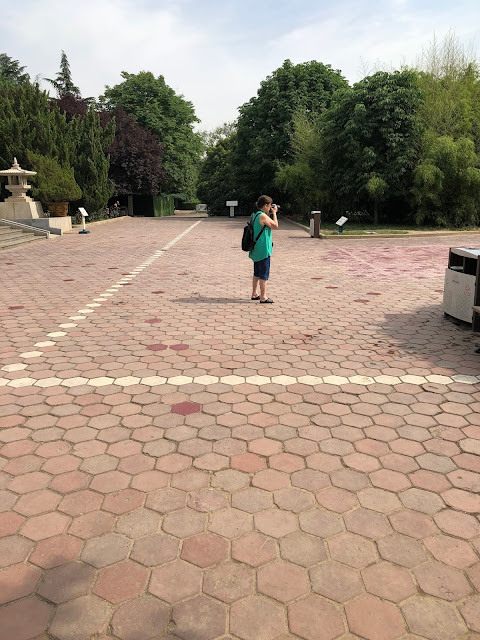 |
| Pit 4 boundaries |
We then left the site and headed for lunch at a shop that, coincidentally, makes terracotta figures for sale to tourists.
They also make lacquered furniture that is also for sale to tourists.
We got back to the hotel about 2:00 pm. We rested up before our dinner theater tonight, the Tang Dynasty Dinner & Show. We met in the lobby at 5:30 am. We arrived at the dinner theater and took a table. The presentation was proceeded by a little band. The main show was music and dance from the Tang dynasty (618-907AD). It was very colorful.
After dinner, we went back to the hotel.
We were told that we needed to have out luggage outside our rooms before 10:00 pm tonight for pickup. We will eat another early breakfast tomorrow (5:00 am) before leaving for the airport at 6:00 am for our flight to Lhasa, Tibet, the Top of the World.







